Ventile
Ventile, is a registered trademark used to brand a special high-quality woven cotton fabric first developed by scientists at the Shirley Institute in Manchester, England. Originally created to overcome a shortage of flax used for fire hoses and water buckets, its properties were also found to be ideal for pilots' immersion suits.[1]
Extra-long-staple (ELS) cotton fibres are used to form a low-twist yarn, which is then woven into a tight high-density textile to create a 100% cotton fabric, capable of providing an effective barrier against inclement weather. In wet weather the softly spun yarns - within the tight weave - dynamically expand to form an effective barrier against the elements.[2]
Currently the only manufacturer of this specification of cotton textile is the Swiss firm Stotz & Co AG,[3] which spins, twists, weaves and dyes the raw materials, and sells the textile directly under its own branding of etaProof[4] cotton, supplying clothing manufacturers and wholesale textile distributors globally.
British production of Ventile eventually ended in the late 20th century[5] but the trademark continued to be used by the British company Talbot Weaving (Chorley) Limited[6] to market their wholesale distribution of etaProof cotton fabrics until 2017 when the trademark ownership was transferred to the manufacturer Stotz & Co AG.[7] Alternative registered trademarks, owned by other commercial organisations used to market, promote or distribute the fabric, include Supermarine[8] and Duuton3.[2]
Technical detail

The cotton textile is densely woven from an extra long staple fibre (ELS). Although weatherproof, it is not coated or laminated; the combination of a dense weave and the swelling of the fibres when wet provide excellent weatherproofing.[6] ELS cotton fibres are only available from around 2% of the world's entire cotton crop, but due to their naturally long length this creates yarns of superior strength as they can be spun using an exceptionally low twist.[9] The natural product offers a high level of comfort due to its drape and breathability, while being durable and quiet in use. It also has good resistance to tearing and burning.[6][10] However, it is not as light in weight as synthetic fabrics, particularly when wet.[10] While only fabrics scoring hydrostatic head measurements of 1000mm or more are technically considered to be fully waterproof, etaProof fabrics (200g to 270g standard versions) achieve measurements no less than 750mm. This is usually considered to be sufficient for reasonable protection against typical rain. The standard 300g version scores 900mm, and the UK Ministry of Defence considers a measurement of 800mm to be "waterproof".[11]
| L35/145 | L34/5640 | L24/5620 | L24RS/5620RS | L19/5610 | L27/5635 | L28/5630 | ||
|---|---|---|---|---|---|---|---|---|
| Fabric weight(g/m2) | 145 | 170 | 200 | 220 | 240 | 270 | 300 | |
| Threads/cm: warp | 92 | 96 | 81 | 66 | 68 | 71 | ||
| Threads/cm: weft | 41 | 35 | 30 | 26 | ||||
| Breaking strength: warp minimum(N/5 cm) | 1000 | 1100 | 1200 | 1400 | 1200 | 1500 | ||
| Breaking strength: weft minimum(N/5 cm) | 650 | 750 | 1000 | 1400 | ||||
| Tear strength: warp minimum(g) | 900 | 1200 | 1350 | 1800 | 2200 | |||
| Tear strength: weft minimum(g) | 650 | 750 | 800 | 1200 | 1600 | |||
| Impregnation of DWR | fluorocarbon | |||||||
| Water absorption(max. %) | 10 | |||||||
| Resistance to water hydrostatic head(mm) | 750 | 600 | 750 | 900 | ||||
| Oil repellency(rating) | 5-6 | |||||||
L24/5620 and L19/5610 are made also in Organic[14] way, denominated 5620.1 RUC and 5610.1 RUC respectively, replacing the fluorocarbon of DWR with paraffin wax. With this change, three properties worsened:[13] Water absorption changed from 10% to 15%, Resistance to water hydrostatic head changed from 750mm to 600mm and Oil repellency changed from 5-6 to 0.
Uses
Fabrics made from the material are used in outerwear performance garments and have military, medical and workwear applications.
Ventile is still used in military uniforms, especially for pilots flying over water.[15] It is not often used in the United States, but in Europe, especially in the UK, it has had a revival with the bushcraft movement. It is popular with birdwatchers and naturalists because, unlike synthetic fabrics such as Gore-Tex, it is quiet in use.[10] Alternative branding of the textile, such as Duuton3,[2] is designed to promote less emphasis upon waterproofing and to disassociate itself from the reserve of military, vintage or bushcraft use and position its adoption more favourably amidst travel-wear, general outdoor sports and functional fashion as a practical cotton material with coincidental weatherproof characteristics.
See also
References
- Ventile website - history
- Duuton Cotton website
- Stotz website - etaProof
- etaProof website
- Stotz website - etaProof history
- Ventile Fabrics - Talbot Weaving (Chorley) Limited
- Ventile trademark registered status and history
- Outlier website - Supermarine example
- Ebbelsen website - materials
- Review of a jacket made of Ventile
- Outdoor Gear website - Hydrostatic Head
- "Ventile® Specifications". Ventile Fabrics. Retrieved June 26, 2016.
- "Technical Data". Stotz, Architects of Fabrics. Retrieved June 26, 2016.
- "EtaProof Organic Cotton". Stotz, Architects of Fabrics. Retrieved June 26, 2016.
- Ventile Fabrics: Uses


.svg.png)